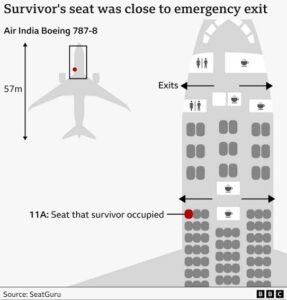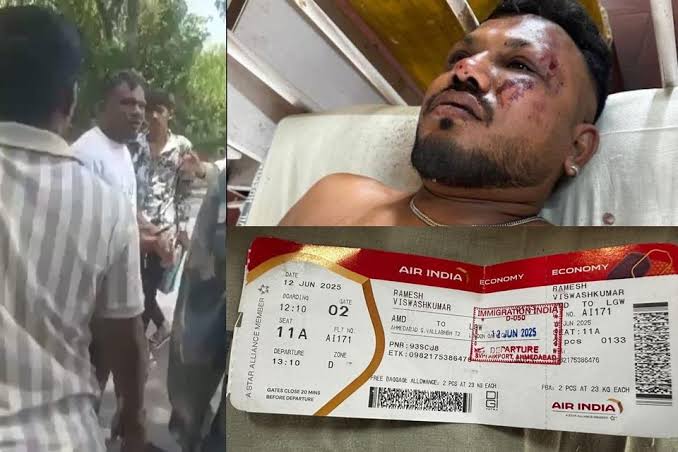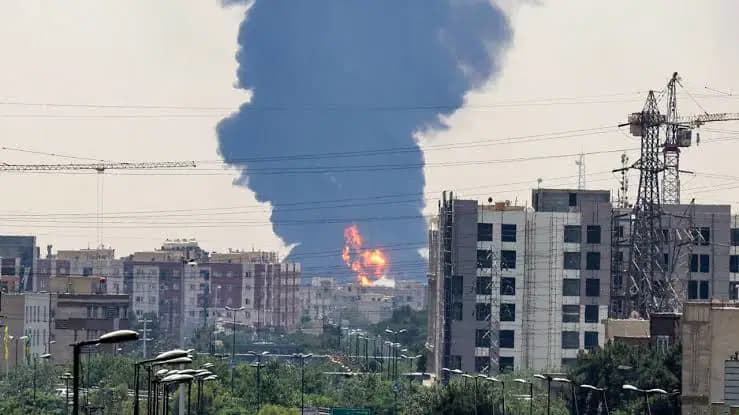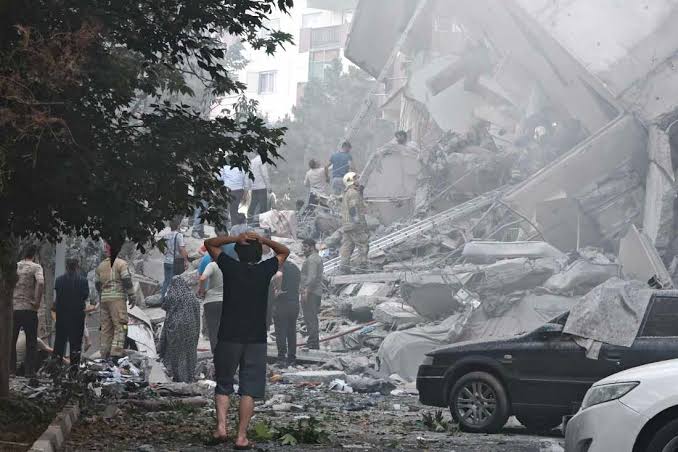Air India Flight 171, a Boeing 787-8 Dreamliner bound for London Gatwick from Ahmedabad, India, crashed moments after takeoff, claiming the lives of 241 passengers and crew members and at least 28 people on the ground. Vishwash Kumar Ramesh, a 40-year-old British national of Indian origin, emerged as the sole survivor, escaping through a broken section of the fuselage near an emergency exit. His account, shared from his hospital bed at Ahmedabad’s Civil Hospital, offers a detailed perspective on the catastrophic event that unfolded in the Meghani Nagar residential area.
The flight, carrying 230 passengers and 12 crew members, including 169 Indian nationals, 53 British nationals, seven Portuguese nationals and one Canadian, departed Sardar Vallabhbhai Patel International Airport at 1:38 p.m. local time. Within 30 seconds, Ramesh, seated in 11A next to an emergency exit, sensed trouble as the plane failed to gain altitude. He described to the Hindustan Times, “When the flight took off, within five to 10 seconds, it felt like it was stuck in the air. Suddenly, the lights started flickering—green and white—then the plane rammed into some establishment.”
The aircraft crashed into a medical college hostel at BJ Medical College Civil Hospital, triggering a massive fire fueled by approximately 125,000 liters of jet fuel. Ramesh recalled a loud noise followed by chaos, with the section of the plane where he was seated breaking off and landing on the ground, sparing him from the flames that consumed much of the fuselage. “When I got up, there were bodies all around me. I was scared. I stood up and ran,” he said, noting the lifeless forms of air hostesses and passengers nearby.
Ramesh unbuckled himself and crawled through a gap in the wreckage, a moment he described to DD News: “I don’t believe how I survived. For some time, I thought I was also going to die. But when I opened my eyes, I realized I was alive and I tried to escape from where I could.” His seat’s proximity to the emergency exit likely aided his survival, as studies show passengers within five rows of an exit have better odds in a crash. Social media footage showed Ramesh limping from the wreckage, bloodied and clutching his boarding pass, confirming his seat assignment.

Ramesh sustained impact injuries to his chest, eyes and feet, with cuts, a swollen eye, and a forehead gash. Dr. Dhaval Gameti at Civil Hospital described him as disoriented but stable, while Dr. Rajnish Patel noted his condition was “not very critical,” with potential discharge within days. Emotionally, Ramesh was devastated, repeatedly asking about his brother, Ajay Kumar Ramesh, 45, seated elsewhere and presumed dead.
The crash site, 1.7 kilometers from the airport, was catastrophic, with the plane’s tail lodged in the hostel and thick smoke rising from the wreckage. The fire’s intensity, as noted by Home Minister Amit Shah, made rescue efforts nearly impossible, with Ramesh as the only passenger found alive. Six National Disaster Response Force teams, fire engines, and ambulances responded, but 28 ground victims, including medical students, perished when the plane hit the hostel’s dining area.
Ramesh’s survival was called miraculous by his family. His brother Nayan, 27, from Leicester, England, shared with Sky News a video call from Vishwash post-crash: “He said, ‘Oh the plane’s crashed. I don’t know where my brother is. I don’t know how I’m alive.’” The family, grieving Ajay’s loss, hoped for another miracle, but authorities confirmed no other survivors.
Prime Minister Narendra Modi visited Ramesh on June 13, 2025, and posted on X, “The tragedy in Ahmedabad has stunned and saddened us. It is heartbreaking beyond words.” Modi inspected the crash site, where a black box was recovered, potentially holding clues to the cause. India’s Aircraft Accident Investigation Bureau, with the National Transportation Safety Board and Boeing, is probing possible wing flap or engine issues, though no cause is confirmed.
This was the first fatal Boeing 787-8 crash, shocking aviation experts given the aircraft’s safety record over 15 years and 41,000 flight hours for VT-ANB. Boeing offered condolences and investigation support, while discussions emerged about grounding Air India’s 787 fleet. The Directorate General of Civil Aviation is monitoring the situation closely.
At Civil Hospital, families provided DNA samples to identify victims, many unrecognizable due to the fire. Among the deceased were former Gujarat Chief Minister Vijay Rupani, a Gloucester family of three, and Canadian dentist Nirali Sureshkumar Patel. The Federation of All India Medical Association reported five medical students killed and 50 injured on the ground.
Ramesh, a businessman living in London for 20 years with his wife and child, had been visiting family in Diu, Gujarat, with Ajay. “We were supposed to go home together,” he told hospital staff, grieving his brother’s loss. His cousin, Ajay Valgi, told the BBC Ramesh was “fine” but shaken, unaware of Ajay’s fate.
The crash, one of India’s deadliest aviation disasters, has raised global aviation safety concerns. Ramesh’s survival, aided by a last-minute seat change to 11A, underscores the role of exit proximity in crashes. “I saw people dying in front of my eyes—the air hostesses, and two people near me,” he told the Hindustan Times, capturing the horror.
Ahmedabad remains in mourning, with emergency services supporting families. Tata Group, Air India pledged 10 million rupees (£86,000) per victim’s family and the government promised aid. Ramesh’s survival, amid 269 deaths, stands as a testament to resilience, his story a focal point in the ongoing investigation and recovery efforts.




